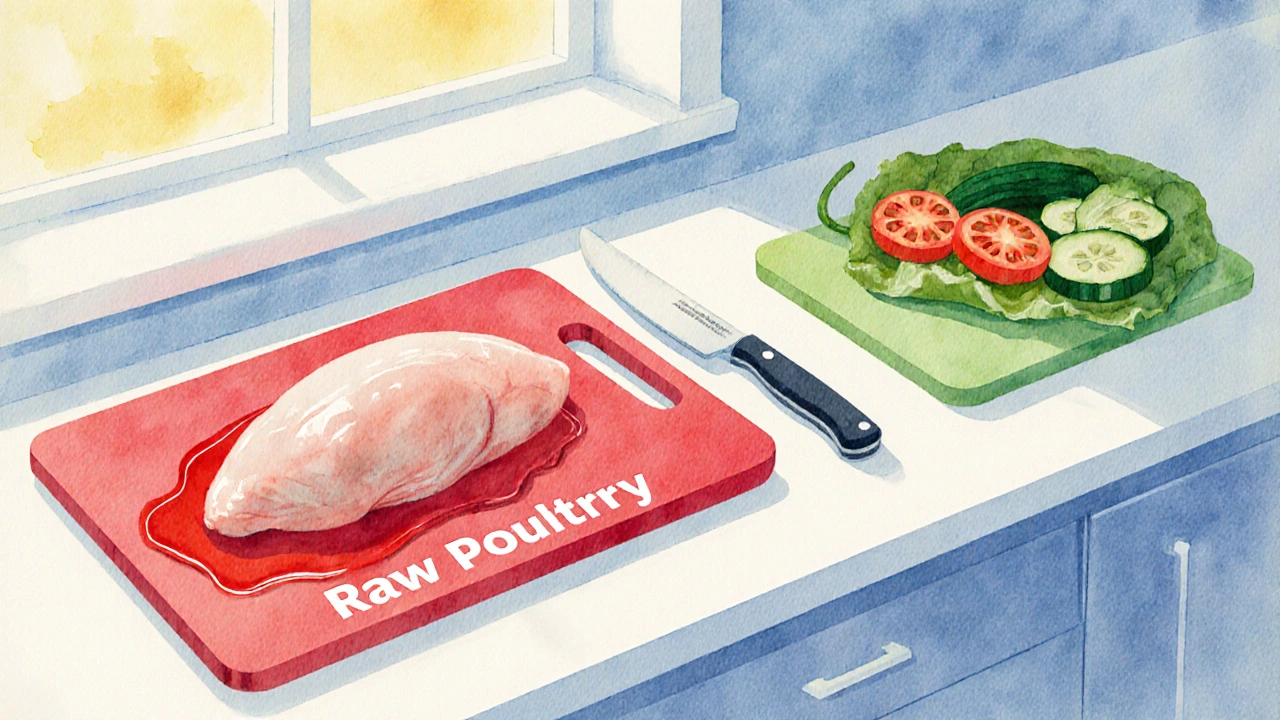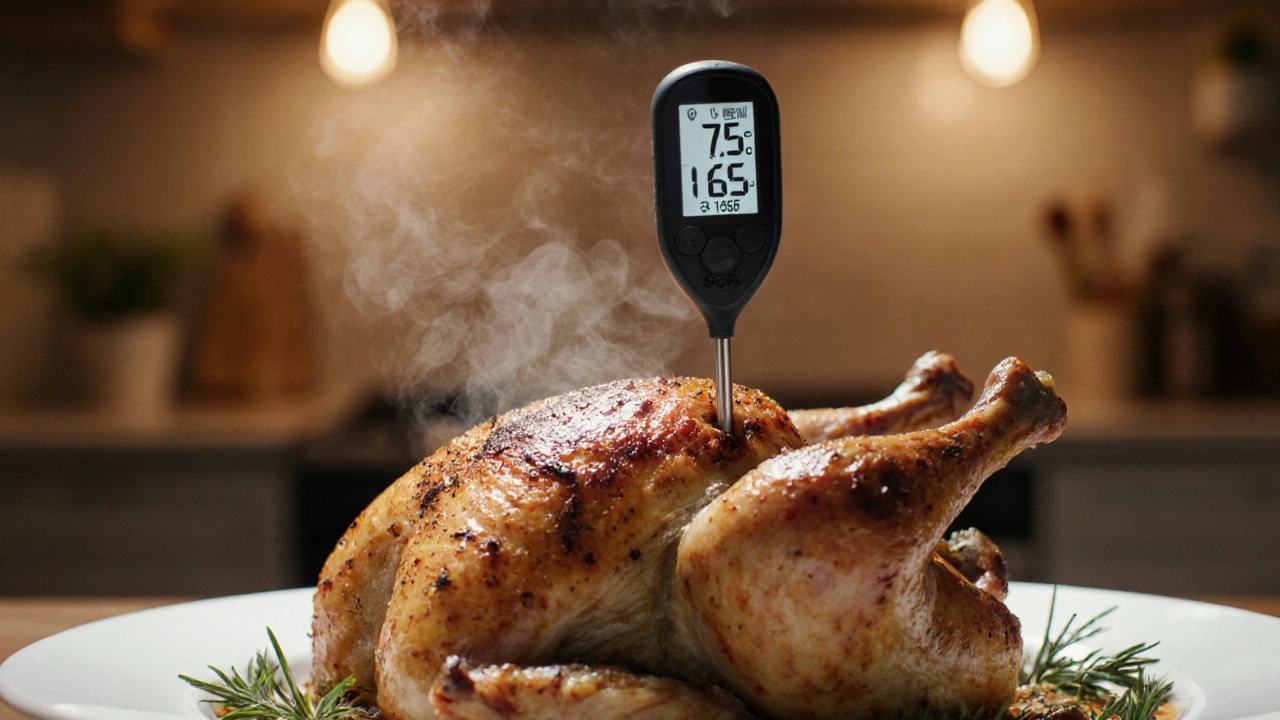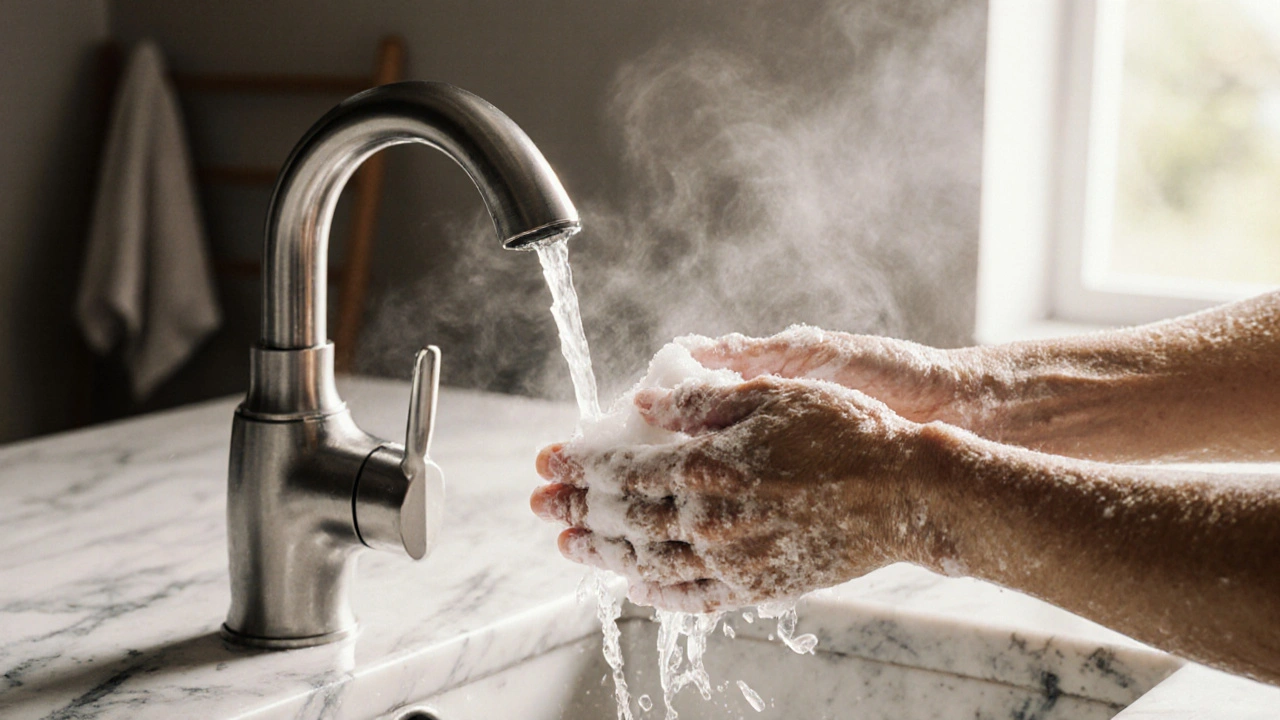Food Safety Temperature Calculator
Is Your Food Safe to Eat?
Enter the internal temperature of your food and select the food type to check if it's safe to eat.
Salmonellosis claims thousands of UK cases each year, and most infections start right in the home kitchen. If you’ve ever wondered how tiny bacteria on a chicken breast can turn a family dinner into a sick day, you’re not alone. The good news? A handful of simple habits can prevent salmonellosis without turning cooking into a science experiment.
Salmonellosis is a foodborne illness caused by the bacterium Salmonella, leading to diarrhea, fever, and abdominal cramps, is responsible for roughly 35,000 cases in the UK each year, according to Public Health England. Most of those infections stem from mishandling raw poultry, eggs, or fresh produce at home.
Key Takeaways
- Wash hands for at least 20 seconds with soap before and after handling food.
- Separate raw animal products from ready‑to‑eat items to stop cross‑contamination.
- Cook foods to the right internal temperature and verify with a reliable food thermometer.
- Store perishables at 4°C (40°F) or below and keep the fridge organized.
- Sanitize surfaces, utensils, and cutting boards after each use.
Understanding the Germ
When you hear the name Salmonella is a rod-shaped bacterium that thrives in warm, moist environments and can survive on foods for weeks, the first thought might be “only restaurants are risky.” In reality, the organism lives on farms, in animal guts, and can hitch a ride on kitchen tools. Even a few hundred cells are enough to cause illness, especially in children, the elderly, and anyone with a weakened immune system.
The Kitchen as a Breeding Ground
Our kitchens combine heat, moisture, and food residue-perfect conditions for bacterial growth. The kitchen is a high‑traffic area where raw foods, cooked dishes, and cleaning activities intersect, creating many opportunities for microbes to move. Understanding where those opportunities appear helps you block them before they become a problem.

Core Prevention Steps
-
Hand Washing - Treat your hands as the first line of defense. Wet them, lather with soap, and scrub for at least 20 seconds, paying attention to fingernails and the backs of hands. Rinse with clean water and dry with a single‑use paper towel.
Hand washing is a hygienic practice that physically removes pathogens from the skin, reducing the chance of transferring them to food.
-
Separate Raw and Cooked - Use different cutting boards for raw meat and for vegetables. Never place cooked food on a plate that previously held raw items.
Cross‑contamination is a process where harmful bacteria are transferred from one surface or food type to another, often via knives, boards, or hands. Color‑coded boards (e.g., red for meat, green for veg) make this habit visual and easy.
-
Cook to Safe Temperatures - Invest in a calibrated food thermometer. Chicken, turkey, and minced meats must reach 75°C (165°F). Eggs should be cooked until both whites and yolks are firm. For leftovers, reheat to at least 74°C (165°F).
Food thermometer is a device that gives an accurate internal temperature reading, ensuring foods hit the kill‑step for Salmonella. Check the reading in three places for thick cuts.
-
Store Food Correctly - Keep your refrigerator at 4°C (40°F) or lower. Store raw meat on the bottom shelf in a sealed container to prevent drips. Use clear containers for leftovers and label them with the date.
Refrigerator is a cooling appliance that slows bacterial growth, buying you time before cooking is needed. A simple thermometer placed on the middle shelf gives a quick check.
-
Clean and Sanitize Surfaces - After each cooking session, wash counters, sinks, and utensils with hot, soapy water. Follow with a sanitizing solution (e.g., 1tbsp bleach per litre of water) and let it air‑dry.
Cutting board is a surface that can harbor bacteria in cracks; cleaning it with hot water and sanitizer removes residual pathogens. Replace plastic boards that become heavily scored.
-
Thaw Safely - Never thaw meat on the countertop. Use the refrigerator, a sealed bag in cold water (change water every 30minutes), or the microwave’s defrost setting if you’ll cook immediately.
-
Reheat Leftovers Properly - Heat soups, stews, and casseroles until they boil vigorously for at least one minute. Stir halfway through to eliminate cold spots.
Why Temperature Matters
Salmonella dies at 60°C (140°F) if held for at least 30 seconds, but most home cooks aim for a safety margin. Reaching the target quickly cuts down the time the bacteria have to recover.
Cooking temperature is a specific heat level that must be reached inside food to kill harmful bacteria, typically 75°C (165°F) for poultry. A thermometer lets you see that number instead of guessing.
Seasonal Tips for Summer Picnics
Warmer weather pushes fridge temps up and shortens the safe window for perishable foods. Keep cold packs in your cooler and place raw meat at the bottom so its juices don’t drip onto salads. When you’re grilling outdoors, use a separate set of tongs for raw meat and for the cooked side, and clean the grill grates with a brush between batches.
If you plan to serve cold dishes like potato salad, keep the bowl on ice until the moment you serve. Re‑heat any leftover grilled items to the same 74°C (165°F) threshold before packing them for the next day.

High‑Risk vs Low‑Risk Foods
| Food Category | Typical Contamination Level | Safe Cooking / Handling Tip | Storage Advice |
|---|---|---|---|
| Raw poultry | High | Cook to 75°C (165°F) measured with a thermometer | Bottom fridge shelf, sealed |
| Eggs (in shell) | Medium | Cook until yolk and white are firm; avoid raw sauces | Refrigerate, use within 3 weeks |
| Fresh leafy greens | Medium | Rinse under running water; consider soaking in vinegar solution | Store in crisper drawer, dry |
| Unpasteurized dairy | High | Heat to 72°C (162°F) before use or choose pasteurized | Keep cold, use quickly |
| Cooked leftovers | Low (if stored) | Reheat to 74°C (165°F) before serving | Consume within 2 days, airtight container |
Common Mistakes and Fixes
- Rinsing chicken - Many think rinsing removes bacteria, but it actually spreads it via splatter. Skip the rinse; cook thoroughly instead.
- Using the same cloth to dry hands and wipe counters - Swap to separate kitchen towels or disposable paper towels.
- Leaving leftovers at room temperature - The “danger zone” (4-60°C / 40-140°F) allows rapid bacterial growth. Transfer to shallow containers and chill within two hours.
- Assuming a smoky smell means food is safe - Visual cues are unreliable; always verify temperature with a thermometer.
Daily Kitchen Safety Checklist
- Hands washed before touching any food.
- Cutting boards clearly labeled and separated.
- Food thermometer calibrated and used for every meat dish.
- Refrigerator temperature checked at least weekly.
- Surfaces sanitized after each prep session.
- Raw items stored on the bottom shelf.
- Leftovers labeled with date and reheated properly.
Frequently Asked Questions
Can I use regular kitchen tongs for raw chicken?
It’s safer to keep tongs dedicated to raw meat or to wash them in hot, soapy water immediately after use. Mixing them with salad tongs creates a cross‑contamination pathway.
How long can I keep cooked chicken in the fridge?
Four days is the generally accepted limit for cooked poultry kept at 4°C (40°F) or below. After that, the risk of bacterial growth rises sharply.
Is a dishwasher enough to sanitize my cutting boards?
Dishwashers clean well, but they don’t always reach the high temperatures needed to kill Salmonella on deep cuts. Follow up with a bleach solution or replace heavily scored boards.
What’s the quickest way to tell if a thermometer is still accurate?
Ice‑water should read 0°C (32°F) and boiling water about 100°C (212°F) at sea level. If the readings are off by more than 2°C, recalibrate or replace.
Do frozen berries pose a salmonella risk?
Frozen berries are usually blanched before freezing, which kills most bacteria. However, if the package is damaged, contamination can reappear, so rinse under running water before use.
By turning these habits into routine, you create a kitchen that’s hostile to Salmonella and friendly to healthy meals. Keep the checklist nearby, revisit the steps whenever you try a new recipe, and you’ll enjoy peace of mind at every dinner table.


Dhanu Sharma
October 12, 2025 AT 04:22Got the checklist printed and stuck it on the fridge it’s a good reminder
Edward Webb
October 13, 2025 AT 08:13Reading through the steps reminded me how the seemingly simple act of washing hands can be a profound gesture of care for our families. By treating each precaution as an ethical commitment, we elevate routine cooking into an act of stewardship. The emphasis on temperature control resonates with the broader principle of respecting the invisible ecosystems within our kitchens. I appreciate the balanced tone that neither sensationalizes the risk nor downplays its seriousness. Maintaining a clean environment, after all, is a shared responsibility that reflects our collective values.
Snehal Suhane
October 14, 2025 AT 12:16I have to say this article is the epitome of culinary hocus‑pocus.
It tells us to wash hands for twenty seconds, as if we are performing a ritual dance.
The suggestion to use a thermometer sounds like a plot by gadget manufacturers to sell more gizmos.
Honestly, who needs precise numbers when you can just eyeball the chicken and hope for the best?
The whole ‘danger zone’ concept is just a marketing gimmick invented by insurance companies.
Also, the claim that salmonella dies at 60°C for thirty seconds is something I read on a random blog, not on any reputable scientific paper.
I suspect the whole safety checklist is a covert operation by the meat industry to scare us into buying pre‑cooked meals.
They even advise storing raw meat on the bottom shelf, which is basically telling you to let it seep into everything else.
Why bother with separate cutting boards when you can just squeeze the juice out of a lemon and claim it’s sanitary?
The recommendation to sanitize with bleach is an excuse to sell more chemicals.
And don’t even get me started on the myth that reheating leftovers to 74°C eliminates all pathogens – it’s a lie.
If you really cared about health, you’d skip the meat entirely and stick to quinoa and kale.
The article’s tone feels like a lecture from a kitchen police officer who never ate pizza.
I’m pretty sure the author never cleaned a kitchen in real life.
Overall, the ‘simple tips’ are anything but simple, and they’re definitely overcomplicating something that anyone can figure out.
So, thanks for the paranoia, but I’ll keep my chicken as raw as possible and hope for the best.
Ernie Rogers
October 15, 2025 AT 16:20Interesting take but honestly most people just freak out over a thermometer
Eunice Suess
October 16, 2025 AT 20:23Honestly the idea of sanitizing everything makes my blood boil why are we even pretending we’re not already in a petri dish The author’s obsession with bleach is a tragedy a melodramatic overkill that ignores the simple truth hot water and soap are enough Yet I can’t help noticing the careless misspelling of hygiene throughout a glaring sign of a rushed job Still the drama in the language is spectacular it reads like a soap opera in a kitchen I’m torn between admiration for the effort and disappointment for the sloppy execution
Anoop Choradia
October 18, 2025 AT 00:26It is worth noting that the emphasis on temperature control may serve purposes beyond mere public health. In highly regulated societies, the propagation of elaborate safety protocols can function as a subtle instrument of governmental oversight, ensuring that citizens remain dependent on certified equipment and professional consultation. The insistence on calibrated thermometers, for instance, aligns with a broader agenda to embed surveillance capabilities within domestic environments. Moreover, the suggestion to label leftovers with dates subtly reinforces a culture of meticulous record‑keeping, a hallmark of bureaucratic governance. While the advice appears benign, one must remain vigilant to the possibility that such guidelines are part of a coordinated effort to standardize behavior under the guise of safety.
bhavani pitta
October 19, 2025 AT 04:30While the guide extols rigorous hand washing, one could argue that over‑emphasis on hygiene paradoxically fosters a false sense of security, prompting diners to neglect the more critical factor: proper sourcing of ingredients. The notion that refrigeration at 4°C is sufficient fails to address the reality that many pathogens originate long before they reach the domestic fridge, often embedded within the supply chain. Thus, the checklist, though well‑intentioned, may inadvertently distract from the upstream challenges that truly dictate food safety.
duncan hines
October 20, 2025 AT 08:33Wow this “expert” advice is just a circus of fear‑mongering it’s like they want us to live in constant terror of invisible bugs. The whole thermometer obsession is a scam to push pricey gadgets on unsuspecting home cooks. Also the claim about 60°C killing salmonella is bogus, I’ve seen labs where it survives! Stop the hype and eat what you want without this nonsense.
Mina Berens
October 21, 2025 AT 12:36Just printed the checklist and put it on the fridge 😅👍 It’s super handy and I love the reminder to keep the fridge at 4°C 🥶🍗
Chris Meredith
October 22, 2025 AT 16:40Let’s turn these safety steps into a power‑up for your kitchen! By treating hand‑washing as a pre‑flight check, you activate a health shield. Using a calibrated thermometer is your “critical hit” against pathogens, and segregating raw and cooked ingredients creates a clean‑room environment. Store perishables at 4°C to keep the bacterial growth rate down to a trickle, and you’ll see performance gains in both taste and safety. Keep the momentum, stay vigilant, and your meals will consistently level up!
Jessie Eerens
October 23, 2025 AT 20:43Indeed, the article presents a comprehensive overview,; however, one must consider the underlying principles,; namely, that proper hygiene, temperature control, and cross‑contamination prevention are integral to food safety; consequently, adherence to these guidelines not only reduces the risk of salmonellosis, but also promotes overall public health; let us, therefore, embrace these practices with diligence and conviction.
Caroline Lane
October 25, 2025 AT 00:46It’s absurd how some people ignore basic food safety and then blame the victims when they get sick. We have a responsibility to ourselves and our families to follow these simple steps, and failing to do so is just selfish. If you think you’re too busy to wash your hands, think again – a few extra seconds could save a life.
Ellie Haynal
October 26, 2025 AT 03:50Every time I see a kitchen neglect basic safety, I feel a surge of frustration. The checklist isn’t just a set of rules; it’s a moral imperative that protects the vulnerable – children, the elderly, anyone with a weakened immune system. We must champion these practices, demand they be taught in schools, and hold each other accountable. Let’s turn compassion into action, one cleaned cutting board at a time.